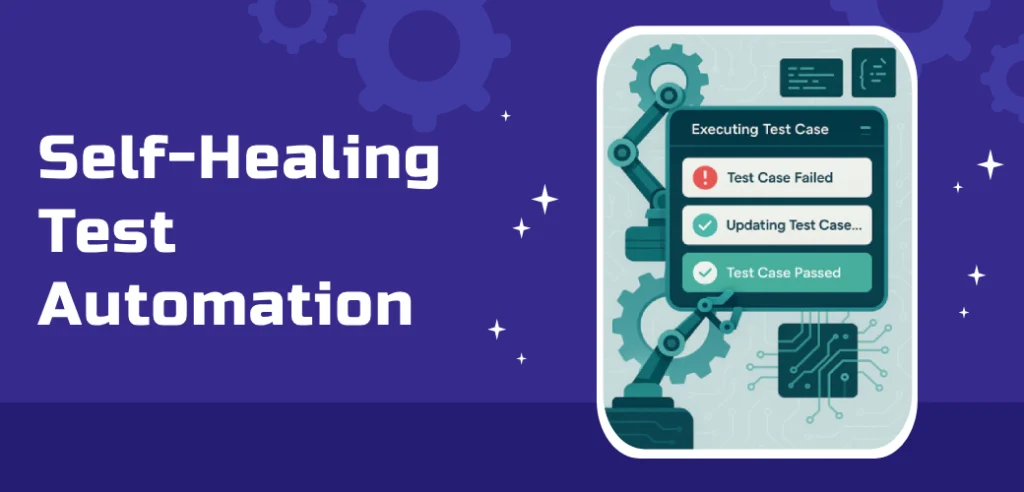
In the ever-evolving landscape of software development, investing in self-healing test automation to ensure the reliability and efficiency of software products is paramount for successful future test runs. One of the critical components in achieving this goal is thorough and effective software testing. As applications become more complex, traditional test automation methods often struggle to keep pace. This is where self-healing test automation emerges as a game-changer, offering a more robust and adaptable approach to automation testing tools.
Understanding Self-Healing Test Automation
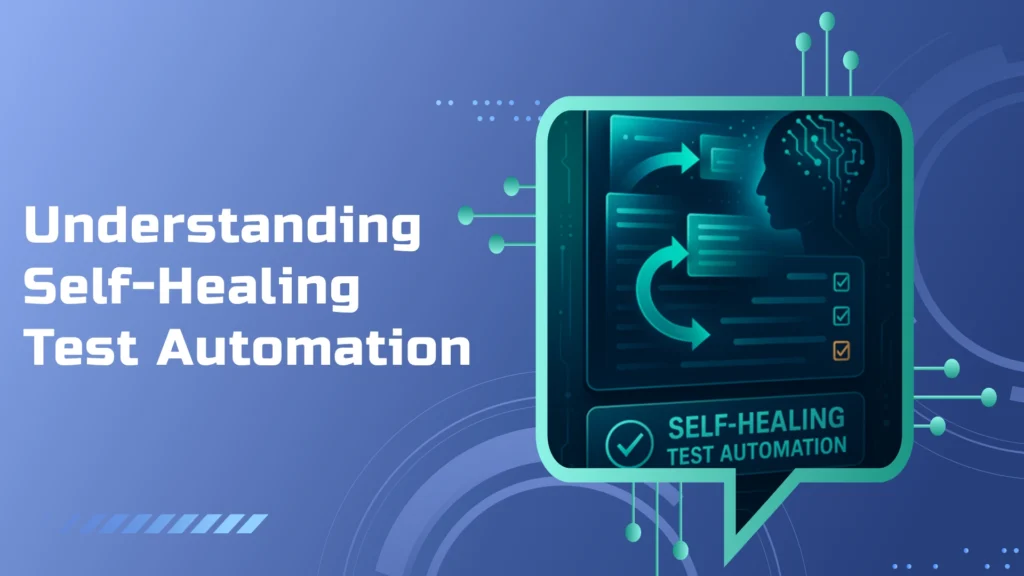
What is Self-Healing Test Automation?
Self-healing test automation is an advanced software testing technique where automated tests possess the capabilities to automatically adapt and correct themselves when encountering minor changes in the application’s user interface or underlying code, self-healing test automation detects changes that may affect test performance. Unlike traditional test automation, where a test script failure often requires manual intervention to update test scripts, self-healing test automation minimizes such interventions. This is achieved through a self-healing mechanism, often powered by AI, which allows the automation framework to dynamically identify and adjust to changes, ensuring test continuity and reducing test maintenance costs. The goal is to maintain test stability and reduce the amount of time spent on test maintenance.
The Importance of Self-Healing in Automated Tests
The importance of self-healing in automated tests cannot be overstated, as self-healing test automation is a game-changer that significantly contributes to the resilience of automated tests. In traditional test automation, even minor modifications to the application under test can lead to tests failing to locate elements, causing test execution to halt and requiring manual intervention to update test scripts. This results in increased test maintenance, significant delays in the testing process, and increased costs for maintaining broken tests. Self-healing test automation addresses these challenges by enabling the automation tool to automatically detect and adapt to these changes, making it a game-changer in modern test automation. This is especially valuable in agile development environments where frequent updates necessitate continuous testing and ensuring test execution in self-healing automation, ultimately improving future test runs. By minimizing the need for manual updates, self-healing test automation reduces the overall cost of software testing and accelerates the delivery of high-quality software.
The Evolution of Test Automation
The journey of software testing has evolved significantly over the years. Initially, manual testing was the norm, a labor-intensive and time-consuming process, but the advent of codeless automation has transformed this landscape. As software complexity grew, the need for more efficient methods led to the development of traditional automation tools. These tools relied on rigid test scripts that were highly susceptible to breaking when the application’s user interface changed. This resulted in a high degree of test maintenance and often limited the test coverage that could be achieved. The advent of self-healing test automation represents the next stage in this evolution, offering a more adaptable and resilient approach. By incorporating AI-based self-healing capabilities, self-healing automation tools can dynamically adjust to changes, reducing the burden of test maintenance and enabling greater future test coverage. Self-healing test automation significantly improves the efficiency and effectiveness of the entire software testing lifecycle by ensuring that test scripts remain up to date.
Mechanisms Behind Self-Healing Tests
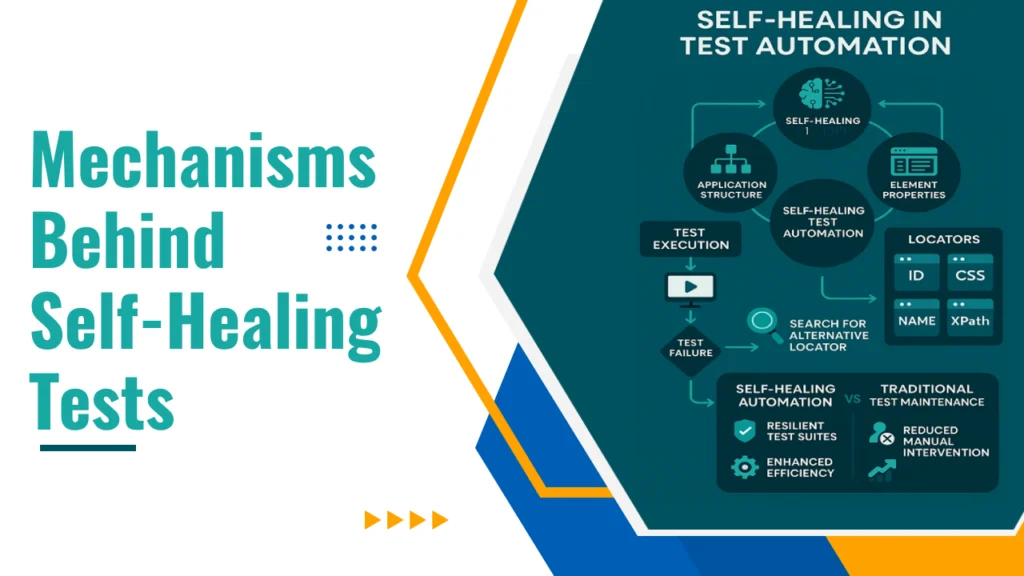
How Self-Healing Mechanisms Work
The inner workings of self-healing test automation involve a sophisticated mechanism that ensures that test automation adapts to changes in the application under test, enhancing the resilience of automated tests. Typically, the self-healing automation tool uses AI algorithms to analyze the application’s structure, element properties, and relationships between elements, automatically updating test scripts accordingly. When a test fails to locate an element, the self-healing test automation tool automatically searches for alternative locators or adjusts existing ones based on the learned patterns. This self-healing capability ensures that the test execution can continue without manual intervention, as self-healing test automation removes disruptions and reduces the need for manual test maintenance.
Key Components of Self-Healing Automation
Several key components enable self-healing in test automation. First, there’s the self-healing mechanism, often powered by AI, which analyzes the application’s UI and underlying code to identify changes and automatically updates the test scripts accordingly. The next critical component is the self-healing test automation framework, which provides the structure for creating and executing self-healing tests. This framework typically includes element locators, such as IDs, XPath expressions, or CSS selectors. Furthermore, reporting and logging mechanisms are essential for tracking self-healing actions and ensuring test continuity, particularly during test updates. These components work together to facilitate the automatic adaptation of automated tests, reducing test maintenance costs.
Examples of Self-Healing Capabilities in Testing Tools
Many self-healing test automation tools showcase impressive capabilities that ensure effective test execution and automation significantly reduces the burden of manual interventions. For example, if an element’s ID changes, a self-healing automation tool can automatically locate the element using other attributes like its text or position relative to other elements, ensuring resilience of automated tests. Some testing tools can even use AI-driven automation to identify broken tests based on their appearance. Furthermore, self-healing automation might update test scripts in real-time during test execution, ensuring test cases continue to run even after updates to test scripts. These examples illustrate the potential of self-healing automated tests to reduce test maintenance and increase test coverage.
Benefits of Self-Healing Test Automation
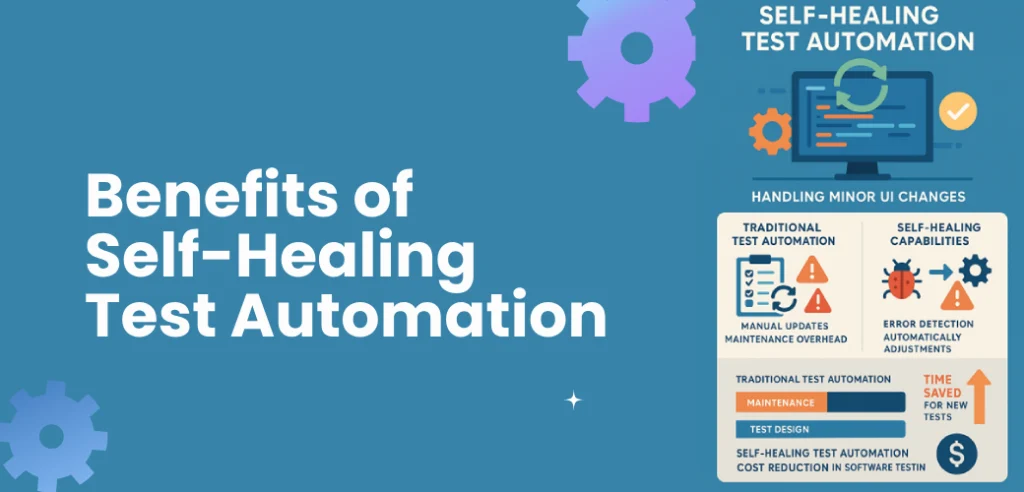
Reducing Maintenance Overhead
One of the most significant benefits of self-healing test automation is its ability to update the test script to reflect changes, thereby reducing test maintenance overhead. Traditional test automation often requires significant effort to maintain test scripts as the application under the test evolves. Self-healing test automation minimizes the need for manual updates, because self-healing capabilities address minor changes in the application’s user interface or code, allowing teams to spend more time fixing tests. This frees up valuable time and resources for test teams, allowing them to focus on other critical tasks such as designing new tests or improving effective test coverage. Self-healing test automation reduces the overall cost of software testing by minimizing the time spent on fixing flaky tests.
Enhancing Test Reliability and Accuracy
Self-healing test automation enhances both the reliability and accuracy of software testing. By automatically adapting to changes in the application, self-healing automation helps ensure that automated tests remain valid and effective over time. This is in contrast to traditional test automation, where tests failing to locate can quickly become obsolete due to even minor modifications, underscoring the need for a robust test automation strategy. Self-healing automation reduces the likelihood of false negatives, improving the accuracy of test results and enabling teams to identify and fix issues more quickly, which also improves test coverage. Ensuring test continuity with self-healing test automation minimizes disruptions to the software development process.
Facilitating Continuous Integration and Delivery
Self-healing test automation plays a crucial role in facilitating continuous integration and continuous delivery (CI/CD) pipelines by maintaining automated tests against software. In a CI/CD environment, frequent updates and changes to the application are common. Self-healing automation ensures that automated tests can keep pace with these changes, providing rapid feedback on the quality of each build while reducing the need to test scripts manually. By minimizing test maintenance and reducing the risk of test failures, self-healing test automation supports the fast-paced nature of CI/CD, enabling teams to deliver high-quality software more quickly and efficiently. Self-healing test automation significantly improves the efficiency and effectiveness of testing by reducing the need for fixing test scripts whenever failures occur.
Implementing Self-Healing Automated Tests
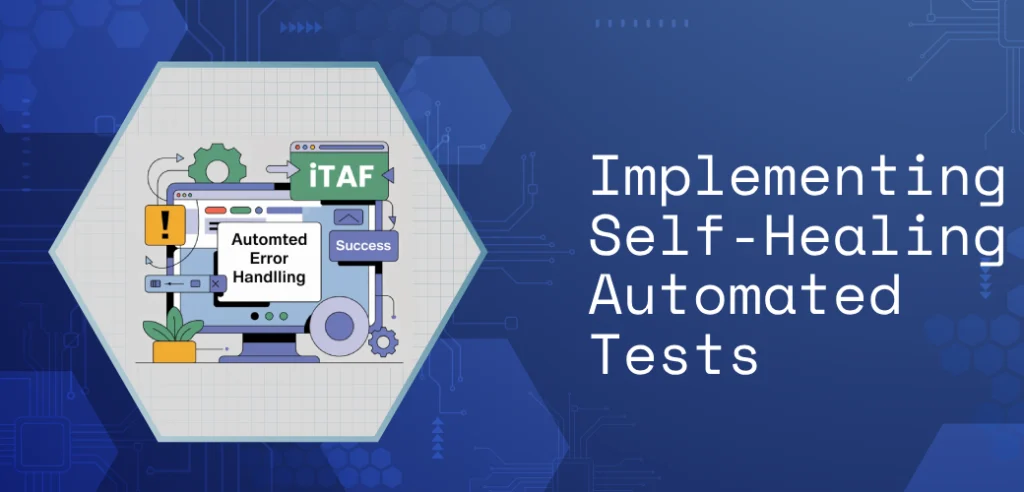
Choosing the Right Automation Tool
Selecting the appropriate self-healing test automation tool is a critical first step to ensure that test processes remain efficient. In implementing self-healing test automation, organizations can greatly enhance their test maintenance by automatically adjusting to changes in their applications. Consider factors such as the tool’s support for various technologies, its ease of use, and its self-healing capabilities to ensure that test scripts remain effective. The best tool should be seamlessly integrated with your existing testing framework, like Selenium, and offer robust reporting features to support a comprehensive test automation strategy. Look for a tool that uses AI-based self-healing to dynamically adjust to changes in the application’s user interface, fixing test scripts accordingly to enhance overall test coverage. Ensure the chosen automation framework has self-healing capabilities to facilitate seamless test updates.
Best Practices for Maintaining Self-Healing Tests
While self-healing automation reduces test maintenance, it doesn’t eliminate it entirely. Regularly review self-healing automation logs to identify patterns of frequent repairs, indicating underlying issues with the application that may require automated tests against software. Prioritize maintaining test code and ensure test cases are well-designed and modular. Keep your self-healing test automation tools up to date to leverage the latest features and improvements in automation testing tools. Establishing these best practices will maximize the benefits of self-healing automation and ensure test continuity by including self-healing capabilities in your strategy.
Integrating Self-Healing Tests into Your Testing Framework
Integrating self-healing automated tests into your existing testing framework requires careful planning. Begin by identifying the areas of your application that are most prone to change and prioritize them for self-healing automation. Ensure that the tool can seamlessly integrate with your continuous integration and continuous delivery (CI/CD) pipeline. Establish clear guidelines for test case creation and maintenance to ensure consistency. Properly integrating self-healing tests with your self-healing test automation framework can significantly reduce test maintenance costs and require maintaining test scripts.
Challenges and Considerations
Limitations of Current Self-Healing Technologies
Despite the benefits of self-healing test automation, current tools are not without limitations. They may struggle with complex UI changes or dynamically generated content. AI-based self-healing algorithms are constantly evolving, and their accuracy can vary depending on the application’s complexity. It’s important to understand these limitations and supplement self-healing test automation with manual testing and traditional automation where necessary to avoid flaky tests. Self-healing automation reduces manual intervention but doesn’t eliminate it completely, as test maintenance by automatically adjusting scripts is still necessary.
Common Pitfalls in Implementing Self-Healing Test Automation
Several common pitfalls can hinder the successful implementation of self-healing test automation, like test misconfigurations, which can lead to automated tests failing. One common mistake is neglecting to properly configure the tool. Another is relying solely on self-healing automation without investing in proper test design and maintenance, which can lead to flaky tests and insufficient overall test coverage. Failing to adequately train the tool on your application’s unique characteristics can also lead to inaccurate repairs, which self-healing tools gather data to address. Avoiding these pitfalls requires careful planning, proper training, and a balanced approach to software testing.
Future Trends in Self-Healing Automation
The future of self-healing automation looks promising, with several trends poised to shape its evolution. The mechanism will become more sophisticated, with AI algorithms capable of handling increasingly complex UI changes. The integration of visual AI will enable tools to identify and repair broken tests based on their visual appearance. Furthermore, self-healing automation will become more accessible, with user-friendly interfaces and cloud-based solutions making it easier for teams to adopt this powerful technology, further ensuring test continuity by minimizing failing to locate.